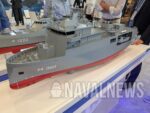BAE Systems is studying the feasibility of integrating the Advanced Precision Kill Weapon System II (APKWS II) onto the Eurofighter Typhoon as a cost-effective counter-unmanned aerial system (C-UAS) solution. This initiative reflects growing demand for affordable air-to-air options to defeat small drones and loitering munitions without expending expensive missiles.
APKWS II: A Proven Precision-Guided Rocket
The APKWS II is a semi-active laser-guided 70 mm (2.75-inch) rocket developed by BAE Systems under a U.S. Navy program. It transforms unguided Hydra 70 rockets into precision munitions by adding a mid-body guidance section with distributed aperture semi-active laser seekers. The system offers an affordable alternative to larger missiles like AIM-120 AMRAAM or AIM-9X Sidewinder in scenarios where targets are small, slow-moving, and low-value—such as Group 1–3 UAVs.
APKWS has seen extensive operational use from rotary-wing platforms such as AH-64 Apache and UH-1Y Venom, as well as fixed-wing aircraft including A-10C Thunderbolt II and F/A-18 Hornet. Its low cost—estimated at under $30,000 per unit—makes it attractive for high-volume engagements.
Rationale Behind APKWS-Typhoon Integration
According to BAE Systems officials speaking at DSEI 2023 and reaffirmed in recent updates from World Defence News (Sept 2025), the company is exploring how APKWS could be adapted for carriage and employment from the Eurofighter Typhoon multirole fighter. The goal is to enable fast jets to engage drone swarms or individual UAV threats using cheaper munitions than traditional air-to-air missiles.
This concept aligns with emerging NATO doctrine emphasizing layered C-UAS architectures that include kinetic interceptors launched from manned fighters when ground-based systems are saturated or unavailable. In particular:
- Small drones often lack radar signatures large enough for conventional missile seekers.
- Using $400K+ missiles against $5K drones is economically unsustainable in attrition warfare.
- APKWS offers proportional lethality with reduced collateral risk due to its smaller warhead (~4 kg).
Technical Challenges and Integration Pathway
The integration of APKWS onto fast jets like the Typhoon poses several technical hurdles:
- Aerodynamic Compatibility: Ensuring stability during high-speed flight envelopes typical of supersonic aircraft.
- Fire Control System (FCS) Integration: Modifying avionics/software to cue laser designation and targeting data for APKWS employment.
- Pylon Adaptation: Configuring launchers compatible with LAU-series pods or custom racks suitable for guided rockets.
BAE has not confirmed whether live-fire testing has occurred but stated that laboratory simulations and wind tunnel assessments are underway. A potential path includes adapting existing Litening III/IV or Sniper Advanced Targeting Pods used on RAF Typhoons to designate targets for APKWS engagement.
C-UAS Use Case Scenarios for Fast Jets
The envisioned role of APKWS-equipped Typhoons would likely focus on expeditionary operations where ground-based C-UAS assets are limited or overwhelmed—for example:
- Austere airbase defense: Intercepting incoming loitering munitions during forward deployments.
- Crisis response missions: Providing organic C-UAS capability during no-fly zone enforcement or show-of-force patrols.
- Saturation swarm attacks: Supplementing SHORAD systems when faced with multiple inbound UAVs simultaneously.
This concept mirrors similar efforts by other nations exploring low-cost interceptors from fast jets—such as Israel’s use of Python-5 against Hamas drones or U.S. Air Force’s interest in modular weapons like SiAW and Rapid Dragon cruise missile dispensers tailored for drone threats.
Strategic Implications and Future Outlook
If successful, this integration could redefine how NATO air forces approach aerial counter-drone missions by leveraging existing platforms with minimal modification costs. It may also influence procurement strategies favoring modular weapon kits over bespoke missile designs in future fighter upgrades like GCAP (Global Combat Air Programme).
The broader implication is that fourth-generation fighters can remain relevant in asymmetric threat environments through smart payload adaptation rather than full platform replacement. Additionally, it opens potential export opportunities where partner nations operate both Typhoons and Hydra-compatible rocket inventories—such as Saudi Arabia or Qatar.









